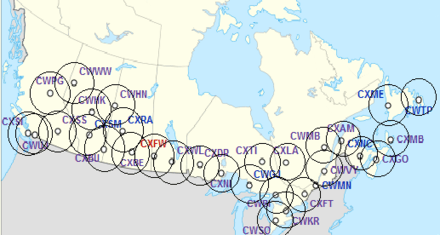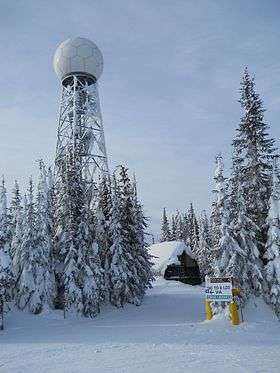Canadian weather radar network

The Canadian weather radar network consists of 31 weather radars spanning Canada's most populated regions. Their primary purpose is the early detection of precipitation, its motion and the threat it poses to life and property. Each has a range of 256 km (159 mi) in radius around the site to detect reflectivity, and a range of 128 km (80 mi) for detecting velocity patterns (Doppler effect).
History
Research in weather radars in Canada began at the end of the Second World War with "Project Stormy Weather".[1] After the war, J.S. Marshall continued at McGill University the work with the "Stormy Weather Group".[2] The Canadian network was thus gradually formed and by 1997, there were 19 weather radars of two kinds across the country: 18 five centimeter wavelength (C-Band) radars and 1 ten centimeter wavelength (S-Band) at McGill, all of the radars detected reflectivity with 3 sites equipped with Doppler capabilities (Carvel, King City and McGill).
Environment Canada received approval in 1998 to upgrade the network to Doppler standard and to add 12 more radars with the operational characteristics coming from King City weather radar station (CWKR), the research radar of Environment Canada.[3] However, McGill radar (at the J. S. Marshall Radar Observatory), while being part of the network, is owned by McGill University. It is a research as well as an operational radar and is modified independently. The Jimmy Lake and Lac Castor stations are owned and operated by the Department of Defense (DND), these are also part of the network.
Characteristics
- McGill radar (at the J. S. Marshall Radar Observatory):[4]
- 9 metre (30 feet) diameter antenna.
- Uses a klystron to produce a wavelength signal of 10 cm. (S-Band)
- Doppler since 1993 and dual polarization was added in 1999.
- King City weather radar station
- This research radar is essentially a WSR-98A (see below) upgraded with dual polarization capability in 2004.

- The rest of the network:[3]
- The upgraded radar have antennas from two manufacturers: Enterprise Electronics Corporation (EEC) and Raytheon.
- The new radar have antennas produced by Andrew Canada. With a diameter almost double the old ones; resolutions improved by the same amount.
- Use 5.6 cm wavelength emitting magnetrons. (C-Band)
- Process received reflectivity and Doppler data with Sigmet Radar Data Systems, now a part of Vaisala Oyj.
- Each radar in the network will thus be called a WSR-98E, WSR-98R or WSR-98A for Weather Surveillance Radar - 1998 (for the year of the start of the program) and the first letter of the manufacturer of the Pedestal/Antenna (Enterprise, Raytheon or Andrew).
- Antennas of 3.6 metres in diameter for the ungraded radars and 6.1 m for the new ones.
- Pulse length and pulse repetition frequency adjustable. Pulse length 0.8,1.6 and 2.0s. Pulse repetition frequency (PRF) 250 Hz and Dual PRF (Doppler Mode) 1190/1200 Hz.
Scanning strategy
Because the network is using C band radars, compromises had to be used (see Doppler dilemma) between maximum reflectivity range and maximum non ambiguous velocities. The actual scanning strategy (2006) is divided in two separate scans over 10 minutes:[3]
- Conventional cycle: 24 elevation angles scanned in 5 minutes to obtain a tri-dimensional view of the atmosphere within 256 km of the radar in reflectivity.
- Doppler cycle: 4 angles scanned in reflectivity and velocities, the first three in a range of 128 km and the last within 256 km. This cycle is used to locate possible small scale rotation and shear in the wind pattern as well as the large scale circulation. The velocity data also help to filter artifacts in the reflectivity such as ground echos.
The McGill radar is currently the only station that uses a S-band transmitter instead of a C-band transmitter to acquire reflectivities and velocities during each of its 24 elevation angles with the same 5 minute cycle time.[4]
Modernization project
Environment Canada received the funding from the Treasury Board in 2011 to undergo a major modernization project called 'WES Renewal' to upgrade to dual polarization all Canadian Radars in two separate five year plans. Complete network stabilization and systemic problems resolution will also be part of this major effort by Environment Canada. The first five years will concentrate on the upgrade of the ten 98A radars to dual polarization. McGill will be upgraded to a new antenna (will either remain S-Band or change to C-Band), but will be operated by Environment Canada in the near future (probably by 2016).[5]
List of radars
The first modernization process began in the fall of 1998 with the opening of Bethune radar and ended in 2004 with the one in Timmins.[6]
See also
- NEXRAD, the weather radar network in United States
References
- ↑ Atlas, David. Radar in Meteorology. American Meteorological Society.
- ↑ "Stormy Weather Group". McGill University. 2000. Retrieved 2006-06-15.
- 1 2 3 Joe, Paul; Steve Lapczak (2002). "Evolution of the Canadian operational radar network" (PDF). Proceedings. 2nd European Conference on Radar in Meteorology and Hydrology (ERAD). Delft, The Netherlands. pp. 370–382. Retrieved 2011-09-19.
- 1 2 J. S. Marshall Radar Observatory (2010). "McGill S-band radar". McGill University. Retrieved 2011-09-19.
- ↑ Government of Canada (January 25, 2012). "Weather Monitoring Infrastructure". Environnement Canada. Retrieved October 29, 2012.
- ↑ "The National Radar Program". Environment Canada. 2004. Retrieved 2006-06-15.
External links
- Real-time Canadian weather radar network data by Environment Canada
- EC's weather radar data products repository
- EC's North-American weather radar mosaic available as a WMS web service